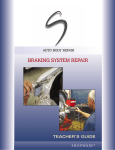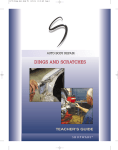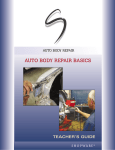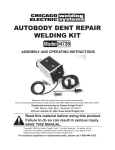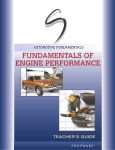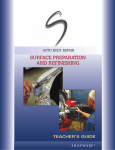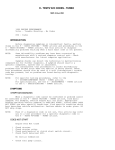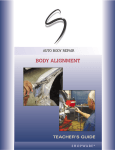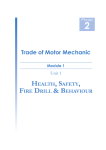Download Teacher`s Guide
Transcript
AUTO BODY REPAIR ELECTRICAL REPAIRS TEACHER’S GUIDE S H O P WA R E ® INTRODUCTION This Teacher’s Guide provides information to help you get the most out of Electrical Repairs. The contents in this guide will enable you to prepare your students before using the program and present follow-up activities to reinforce the program’s key learning points. The Electrical Repairs video looks at common automotive electrical problems. It covers how to use the digital multimeter device called a Digital Voltage Ohm Meter, or DVOM, to measure current, voltage, and amperage, and to check resistance and continuity when testing electrical circuits; inspect, test, and replace fusible links, circuit breakers, and fuses; and work on batteries and alternators. After viewing this video and completing some of the learning activities included in this guide, students will be better prepared to properly work with automotive electrical systems, and incorporate industry terminology in order to communicate effectively with coworkers, parts suppliers, and insurance adjusters. Use the Electrical Repairs video and accompanying activities provided in this guide to prepare students for the most effective way to approach automotive electrical system repairs, and to familiarize students with terminology used in the auto repair industry. LEARNING OBJECTIVES After viewing the program, students will be able to: ■ Demonstrate a basic knowledge of electrical repair operations and safety procedures. ■ Identify the correct tools to use given the task to be performed. ■ Describe procedures used to check voltage, resistance, and amperage in electrical wiring circuits and components. ■ List methods used to inspect, test, and replace fusible links, circuit breakers, and fuses. ■ Define procedures used to inspect, clean, and repair or replace battery cables, connectors, and clamps. ■ Summarize the methods used to inspect, adjust, or replace the alternator drive belts, pulleys, and fans. EDUCATIONAL STANDARDS The primary certifying body for automotive technician training programs is the National Institute for Automotive Service Excellence (ASE). ASE is a non-profit organization established in 1972 by the automotive industry to improve the quality of vehicle repair and service through the voluntary testing and certification of automotive repair technicians. The National Automotive Technicians Education Foundation (NATEF) is a separate non-profit foundation within ASE. The mission of NATEF is to improve the quality of automotive technician training programs nationwide through voluntary certification. The State Departments of Education in all 50 states support ASE/NATEF certification of automotive programs. 2 Copyright © 2005 SHOPWAR E ® National Standards This program correlates with the Program Certification Standards for Automobile Technician Training Programs from the National Institute for Automotive Service Excellence (ASE) and the National Automotive Technicians Education Foundation (NATEF). The content has been aligned with the following educational standards, which reflect the tasks in the ASE Program Certification Standards for Automobile General Service Technician Programs. Mechanical and Electrical Components: Electrical ■ Check voltages in electrical wiring circuits with a DMM (digital multimeter). ■ Check continuity and resistance in electrical wiring circuits and components with a DMM (digital multimeter). ■ Repair electrical circuits, wiring, and connectors according to manufacturer’s specifications. ■ Inspect, test, and replace fusible links, circuit breakers, and fuses. ■ Perform battery state-of-charge test; determine needed service. ■ Inspect, clean, and replace battery. ■ Perform slow/fast battery charge in accordance with manufacturer’s recommendations. ■ Identify programmable electrical/electronic components; record data for reprogramming before disconnecting battery. ■ Inspect, clean, and repair or replace battery cables, connectors, and clamps. ■ Inspect alignment, adjust, and replace generator (alternator) drive belts, pulleys, and fans. ■ Demonstrate the proper self-grounding procedures for handling electrical components. 2004 Automobile Program Standards, by the National Institute for Automotive Service Excellence (ASE), Copyright 2004 Reprinted with permission. Language Arts and Communication Standards According to ASE/NATEF standards, the automobile technician must be proficient in the following Language Arts and Communications related academic skills that are embedded in the occupation. The activities and information presented in this program and accompanying teacher’s guide are aligned to the following standards from the National Automotive Technicians Education Foundation from the National Institute for Automotive Service Excellence. ■ Request, collect, comprehend, evaluate, and apply oral and written information gathered from customers, associates, and supervisors regarding problem symptoms and potential solutions to problems. ■ Identify the purpose for all written and oral communication and then choose the most effective strategies for listening, reading, speaking, and writing to facilitate the communication process. ■ Adapt a reading strategy for all written materials, e.g. customer’s notes, service manuals, shop manuals, technical bulletins, etc., relevant to problem identification, diagnosis, solution, and repair. ■ Use study habits and techniques, i.e. previewing, scanning, skimming, taking notes, etc., when reviewing publications (shop manuals, references, databases, operator’s manuals, and text resources) for problem solving, diagnosis, and repair. ■ Write clear, concise, complete, and grammatically accurate sentences and paragraphs. 3 ■ Write warranty reports and work orders to include information regarding problem resolution and the results of the work performed for the customer or manufacturer. ■ Follow all oral/written directions that relate to the task or system under study. ■ Comprehend and apply industry definitions and specifications to diagnose and solve problems in all automotive systems and components of the automobile and light truck. ■ Comprehend and use problem-solving techniques and decision trees that are contained in service manuals and databases to determine cause-and-effect relationships. ■ Use the service manual to identify the manufacturer’s specifications for system parameters, operation, and potential malfunctions. ■ Supply clarifying information to customers, associates, parts supplier, and supervisors. Standards for the English Language Arts, by the International Reading Association and the National Council of Teachers of English, Copyright 1996 by the International Reading Association and the National Council of Teachers of English. Reprinted with permission. Technology Standards The activities in this Teacher’s Guide were created in compliance with the following National Education Technology Standards from the National Education Technology Standards Project. The content has been aligned with the following educational standards and benchmarks. ■ Use a variety of media and formats to communicate information and ideas effectively to multiple audiences. ■ Use telecommunications to collaborate, publish, and interact with peers, experts, and other audiences. ■ Use productivity tools to collaborate in constructing technology-enhanced models, prepare publications, and produce other creative works. ■ Use technology tools to enhance learning, increase productivity, and promote creativity. ■ Use technology to locate, evaluate, and collect information from a variety of sources. The National Education Technology Standards reprinted with permission from the International Society for Technology Education. PROGRAM OVERVIEW What tools are needed when making automotive electrical repairs? How do you inspect, test, and replace electrical components? These questions and more are answered in the Electrical Repairs video. This program begins by providing a basic overview of electrical concepts and terminology, followed by a review of safety procedures when working with automotive electrical systems. Viewers will have the opportunity to see various electrical tests performed with automotive electrical equipment, and will learn how to test, clean, repair, and replace important automotive electrical components. After viewing this program, viewers will be better prepared to properly make automotive electrical repairs, and will be able to incorporate industry terminology in order to communicate effectively with coworkers, parts suppliers, and insurance adjusters. 4 MAIN TOPICS Topic 1: Concepts and Electrical Terminology This section of the program describes some concepts and electrical terminology that an auto body repair technician needs to know in order to work with a vehicle’s electrical systems. Knowledge of these concepts and terms is essential when making electrical repairs. Topic 2: Safety Procedures This section of the program describes the important safety procedures that must be followed when making any kind of automotive electrical repairs. It is important to keep these procedures in mind and follow them carefully to prevent nasty shocks, electrical fires, and damage to electrical components. Topic 3: Performing Tests This section of the program demonstrates the various tests that can be performed with a DVOM. The information that can be gathered through these tests is the key to diagnosing and fixing auto electrical faults. Topic 4: Fuses and Circuit Breakers Often when one of a vehicle’s electrical devices doesn’t work, the fix can be as easy as replacing a burned out fuse or defective circuit breaker. This topic describes the purpose of fuses and circuit breakers, describes how to test them, and explains how to determine when a replacement is needed. Topic 5: Batteries and Alternators The battery supplies the power to a vehicle’s electrical system. If it isn’t working properly, the vehicle’s electrical systems won’t work right either. This section describes how to inspect and test the battery safely, as well as clean a battery properly. Charging and replacement of batteries is also discussed, along with techniques for testing the alternator and fixing common problems. FAST FACTS ■ The DVOM multimeter is recommended by vehicle manufacturers because it won’t damage a vehicle’s sensitive electronic parts. ■ When making electrical repairs, always disconnect the negative battery terminal. This prevents an electrical fire and protects you from shock when you’re working on the vehicle’s circuits. ■ When disconnecting the battery, the ignition should be off to prevent a voltage spike from damaging any computer electronics. ■ A vehicle’s service manual is very helpful in locating the routing of circuits you’re testing. ■ If a car’s battery tests lower than 12.4 volts, your first course of action is to recharge it. ■ When in the Ohm measuring mode, there must be no power in the circuit being tested or the ohmmeter will be damaged. Either disconnect the part being tested from the power source or disconnect the negative battery terminal. ■ If you don’t calibrate a meter before testing, your measurements will be inaccurate. 5 ■ Every component has a specified minimum resistance value, which can be found in the service manual. If your test shows a value less than the specified minimum, the component is defective and should be replaced. ■ Amperage is measured to test how much power is being used by a device or “load.” ■ Often when one of a vehicle’s electrical devices doesn’t work, the fix can be as easy as replacing a burned out fuse or defective circuit breaker. VOCABULARY TERMS amperage: Unit of measure denoting the strength of an electrical current, measured to test how much power is being used by a device or “load.” autoranging: A feature of some meters which means a user does not have to set the value range for the circuits he/she is testing. battery: The power source in a vehicle’s electrical system is usually the battery. The battery has positive and negative terminals. Electrical current flows out of the positive terminal of the battery and returns to the negative terminal to create a circuit. calibrate: To check, adjust, or determine the reading of a meter by comparison with a standard. circuit: A flow of energy from a positive to a negative terminal. Electrical current flows out of the positive terminal of the battery and returns to the negative terminal to create a circuit. circuit breaker: Protect circuits from excess current. Unlike fuses that burn through, circuit breakers heat up and open the circuit. Once cool, the circuit breaker will close and the circuit will be operational again. conductor: Carry the electrical current through a circuit. Conductors can be wires, or in the case of computers, extremely small metallic traces on a computer board. continuity: A complete circuit. If there is a break, or “open,” in a circuit, electricity cannot flow— it does not have continuity. Continuity is measured with an ohmmeter. corrosion: Typically green and white crystals that appear on a battery, corrosion is a state of deterioration in metals caused by oxidation or chemical action. Corrosion is a normal part of battery life, but if not cleaned away periodically, can damage clamps and cables and inhibit battery operation. current: The flow of electricity through a circuit. Current is measured in amperes, or “amps,” using an ammeter. The number of amps tells how much current is flowing through the circuit. digital multi-meter (DVOM): A device used to measure current, voltage, resistance, and continuity when testing electrical circuits. fuse: A safety device that protects an electric circuit from excessive current. It includes a metal element that melts when current exceeds a specific amperage, which opens the circuit. The purpose of a fuse is to protect circuits and loads from excess current by burning in half and severing the circuit. load: A device on the circuit that converts electrical energy into another form of energy such as light, heat, or movement. ohmmeter: A meter used to measure continuity and resistance. power source: Usually the battery in a vehicle’s electrical system, the power source is the component that provides a charge that causes electrical components within the automobile to function. 6 resistance: Resistance is a restriction that slows down current flow. A typical example of resistance in an electrical circuit might be corrosion on a wire or connector. Resistance in a circuit or electrical system component is measured in ohms using an ohmmeter. resting state-of-charge test: An electrical test performed on a battery when the car is not running and none of the electrical accessories are on. voltage: The pressure that pushes electricity through a wire or circuit. voltmeter: A meter used to measure the voltage of a circuit. PRE-PROGRAM DISCUSSION QUESTIONS 1. Can you name the parts of a vehicle that make up an automobile’s electrical system? 2. What parts of an automobile’s electrical system are similar to those of a house’s electrical system? 3. What tools do you think are used by auto body repair technicians when testing automotive electrical systems? 4. What do you think is the easiest job involved in automotive electrical repair? Which is the most difficult? 5. What safety procedures do you think need to be considered when making automotive electrical repairs? POST-PROGRAM DISCUSSION QUESTIONS 1. How are a vehicle’s power source, conductors, and load related? Why is it important to understand how these work together when making automotive electrical repairs? 2. Why is a DVOM recommended by vehicle manufacturers? What makes it superior to other types of meters? 3. Why is it important to calibrate the DVOM before testing? What could happen if the meter is not calibrated? 4. What safety procedures would you recommend to someone learning about automotive electrical repairs? What, in your opinion, is the most important safety procedure to remember? Why? 5. How are fuses different from circuit breakers? How are they similar? Why do you think both are used in a vehicle’s electrical system? 7 GROUP ACTIVITIES Electrical System Presentation As a group, research the electrical systems found within the automobile of your choice. Then, prepare a poster that illustrates these electrical systems, and a presentation that shows your classmates how each electrical system is designed and depends upon other components within the vehicle. Be prepared to compare the systems within the vehicle your group chose with those of other groups. You Be the Teacher Select one electrical system within a car, such as the ignition system. As a group, prepare a working model of this system, along with a five-question quiz about how to use a DVOM to test your system. Your group will present your working system to the class and demonstrate how to use a DVOM to test this system. Then, your group will distribute the quiz to your classmates in order to see if everyone learned how to test the system. Safety Mistake Skit As a group, prepare a skit that shows a group of auto body repair technicians testing, charging, and finally replacing a battery. In your skit, the technician should NOT follow proper safety procedures. When your group performs your skit for the class, the class should note all of the safety mistakes that your group makes in your skit. After your performance, ask your class to identify all of the mistakes you made. Did they catch them all? Which safety procedures are the hardest for your class to remember, and which mistakes are the easiest to miss? INDIVIDUAL STUDENT PROJECTS Electrical Systems Tests Obtain a DVOM, and ask permission to use it on your family’s or another vehicle. Perform the three tests described in the Electrical Repairs video (battery state-of-charge test, resistance test, and amperage test) and record your readings. Prepare a written document that provides each reading and contains your assessment of the state of the vehicle’s electrical system based on those readings. Fuse Test Photo Timeline Bring your camera along as you test a fuse for resistance. Prepare a timeline of photos that illustrate the sequence measuring a fuse for resistance with a multimeter. Include a photo that demonstrates how to switch to ohmmeter and calibrate the meter, how to place the red and black leads appropriately, and how to read the meter. Mount your timeline on poster paper and prepare to share with the class. Panel Removal Technique Demonstration Create a tri-fold brochure for auto body repair technicians that shows safe automotive battery handling techniques. Be sure to include tips for testing, battery handling, charging, dealing with corrosion, cleaning, and replacement. Include photos or illustrations wherever possible. 8 INTERNET ACTIVITIES Electrical Repair Web Quest With your group, find three to five Web sites that deal with automotive electrical repairs. Write four questions for each Web site that test knowledge of the concepts taught on the site, as they relate to automotive electrical repairs. Be sure to prepare an answer key as well! Then, prepare a handout for the rest of your class that contains the URLs of each Web site, along with your questions. Your teacher will distribute your handout to the rest of the class, and each group in your class will complete your Web Quest. After each group has answered all the questions for each site, your team will be responsible for grading each group’s work and providing feedback. Electrical System Repair—Follow-Up Lesson Plan Visit the Web site http://www.autoshop101.com. Starting at this site, and using others as well, prepare a follow-up lesson for your class on automotive electrical systems. While the Electrical Repairs video provided an overview of electrical systems, decide what other details your class needs to know in order to properly repair electrical systems as an auto body repair technician. Design a lesson plan, including purpose, learning objectives, materials, and instructions for the teacher. Include a list of Web sites used to design your lesson. After review from your teacher, prepare to present your lesson to the class. Automotive Electrical History How long have electrical systems been a part of car design? How have they changed since their inception? Using a search engine, research the history of automotive electrical systems, and write a report that describes how systems were initially used, how they have changed, and what they look like today. Include illustrations wherever possible. ASSESSMENT QUESTIONS Q: Which of the following is not a component of an electrical circuit? (a) Power source (b) Conductor (c) DVOM (d) Load A: (c) Feedback: All electrical circuits have a power source, conductors and a load—a device that converts electrical energy into light, heat, or movement. Q: Which of the following is usually the power source for a vehicle? (a) Battery (b) Fuse (c) Circuit breaker (d) Conductor A: (b) Feedback: The power source in a vehicle’s electrical system is usually the battery. The battery has positive and negative terminals. Electrical current flows out of the positive terminal of the battery and returns to the negative terminal to create a circuit. 9 Q. The flow of electricity through a circuit is called ______________________. (a) current (b) voltage (c) ampere (d) conductor A: (a) Feedback: The flow of electricity through a circuit is called current. Current can be compared to the flow of water through a garden hose. Current is measured in amperes, or “amps,” using an ammeter. The number of amps tells you how much current is flowing through the circuit. Q: Describe the effects of an “open” in a circuit. A: If there is a break, or an “open,” in a circuit electricity cannot flow through that circuit. As a result, an open within a circuit will cause the malfunction of any device connected to that circuit. Feedback: If there is a break, or “open,” in the circuit, the electricity cannot flow because it does not have continuity. If the circuit is complete, it has continuity. Q: What safety procedures must be followed when disconnecting a battery? A: Always make sure the ignition is off, disconnect the negative battery terminal, and don’t smoke or weld near batteries, or expose them to sparks, flames, or heat sources. Feedback: Disconnecting the negative battery terminal prevents an electrical fire and protects you against shock when you’re working on the vehicle’s circuits. When disconnecting the battery, the ignition should be off to prevent a voltage spike from damaging any computer electronics. Finally, don’t smoke or weld near batteries or expose them to sparks, flames or heat sources. Batteries emit hydrogen gas, which can produce an explosion if exposed to heat, flames, or sparks. Q: Which of the following carries the electrical current through the circuit? (a) Conductors (b) Load (c) Voltage (d) Current A: (a) Feedback: Conductors carry the electrical current through the circuit. Conductors can be wires, or in the case of computers, extremely small metallic traces on a computer board. Q: Where can a vehicle’s electrical requirements, including load and resistance, be found? A: This information can be found in the electrical diagram section of the vehicle service manual. Feedback: Before you walk up to a car with your DVOM and begin to test parts, you need to know a little about their electrical requirements, including load and resistance. That’s the key to diagnosing and fixing auto electrical faults. This information can be found in the electrical diagram section of the vehicle service manual. The service manual is also helpful in locating the routing of circuits you’re testing. 10 Q: Most circuits and loads get positive power from the battery, and a return or ground from __________________________. A: the vehicle’s metal chassis Feedback: Most circuits and loads you test will get positive power from the battery and a return or ground from the vehicle’s metal chassis. The negative terminal of the battery is then connected to the chassis and the engine block to complete the circuit. Q: The minimum acceptable reading for a good battery is _______________ open circuit volts. A: 12.4 Feedback: The acceptable minimum reading for a good battery is 12.4 open circuit volts, that is, when all vehicle electrical devices are turned off and the engine is not running. If the battery tests lower than 12.4 volts, the first course of action is to recharge the battery. Q: If a meter is autoranging, it will automatically find the correct range when you begin the test. (True or False) A: True Feedback: Autoranging meters automatically find the correct range when the auto body repair technician begins the test. With a non-autoranging DVOM you’ll also have to select the proper voltage range. ADDITIONAL RESOURCES WEB SITES Auto Body Curriculum Guide www.sasked.gov.sk.ca/docs/paa/autobody/index.html Auto Body Online www.autobodyonline.com Auto Body P.I. www.autopi.com/frame.htm Auto Body Pro www.autobodypro.com Auto Body Tool Mart Repair and Restoration Tutorials www.autobodytoolmart.com/restorations.html Automotive Body Repair News www.abrn.com/abrn Auto Glossary www.autoglossary.com 11 Automotive Learning Online www.innerauto.com Automotive Services Association® www.asashop.org Automotive Youth Educational Systems (AYES) www.ayes.org/index.asp Collision Repair Industry: Insight http://www.collision-insight.com Do-It Yourself Network—Automotive Body Work www.diynet.com/diy/ab_auto_body_work/0,2020,DIY_13675,00.html How Stuff Works—Auto Stuff Page http://auto.howstuffworks.com I-car www.i-car.com National Automotive Service Task Force www.nastf.org National Automotive Technicians Education Foundation www.natef.org OEM Tech Sites: Auto Body Online: A Portal for the Autobody Professional www.autobodyonline.com/industry/OEM/index.cfm Society of Collision Repair Specialists www.scrs.com Tektips—Auto Body Pro Website www.autobodypro.com/tektips.htm BOOKS Duffy, James E., Auto Body Repair Technology, 4th Edition. Delmar Thomson Learning, 2004. ISBN: 0766862747 Chilton Book Company, Chilton’s Auto Repair Manual, 1998-2002 (Chilton’s Reference Manuals). Chilton Book Company, 2003. ISBN: 0801993628 Duffy, James E., I-CAR Professional Automotive Collision Repair. Delmar Thomson Learning, 2001. ISBN: 0766813991 12 OTHER PRODUCTS Auto Body Shop Safety, Software, Cambridge Educational Safety procedures relevant to the auto body shop are outlined, along with lessons on First Aid, Fire Safety and Prevention, Wire Feed MIG Welding, and Proper Use of Auto Body Tools. 3.5” IBM version, Mac version also available. A Shopware Production. Order #: 20941, www.cambridgeeducational.com, 1-800-468-4227 Electrical Systems, Software, Shopware Complete lessons and quizzes on Electrical Systems, Starting Systems, Charging Systems, and Ignitions Systems. 3.5” IBM version, Mac version also available. A Shopware Production. Part of the series Auto Mechanics (order 24018). Order #: 21000, www.shopware-use.com, 1-800-487-3392 Electrical Systems, VHS/DVD, Meridian Education Using 3-D animation and live-action close-ups of electrical system components, these videos examine and explain elements of various systems, troubleshooting, conducting basic tests, and basic repair procedures for many system failures. Also provides detailed information about the proper tools and how to use them. Topics covered include starting motors, solenoids, cables, ignition switches, sensors, multimeters, voltage regulators, alternators, scopes, wiring diagrams, and high-voltage systems. A Meridian Production. The series includes Charging System Operation; Charging System Service; Ignition System Operation; Ignition System Service; Starting System Operation; Starting System Service; Using a Load Tester. Order #: 25289, www.meridianeducation.com, 1-800-727-5507 Electronics GM Computer Command Control, Software, Shopware The General Motors Computer Command Control system is examined along with the automotive electronics and control input/output devices associated with it. 3.5” IBM version, Mac version also available. A Shopware Production. Order #: 20995, www.shopware-use.com, 1-800-487-3392 13 S H O P WA R E ® 2572 Brunswick Pike, Lawrenceville, NJ 08648 w w w. s h o p w a r e - u s a . c o m Call Toll Free: 800/487-3392 32783















